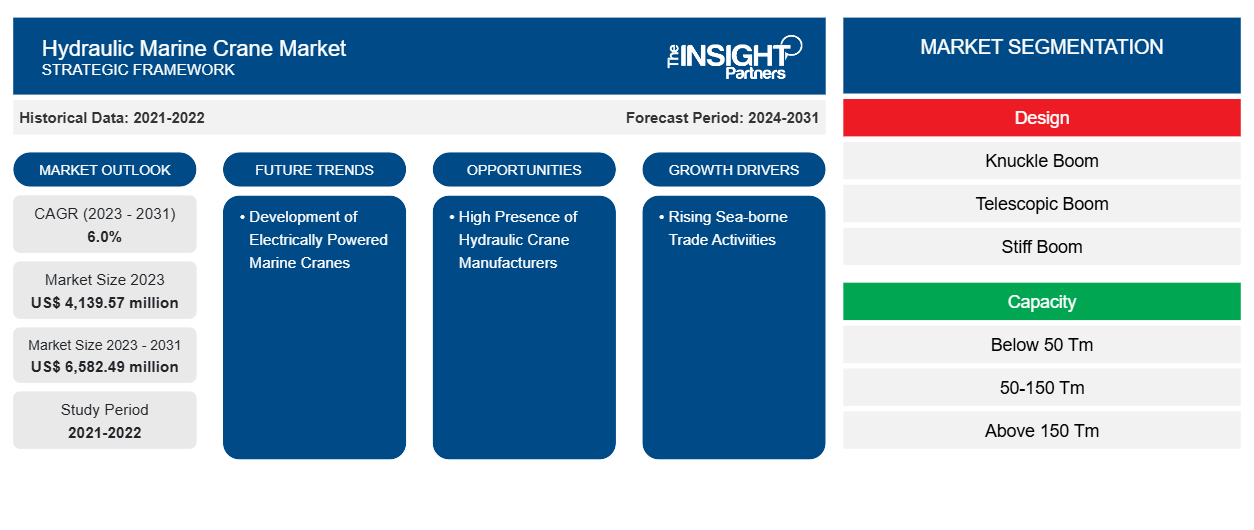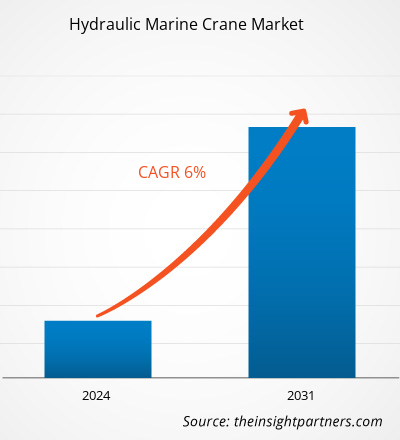The hydraulic marine crane market size is projected to reach US$ 6,582.49 million by 2031 from US$ 4,139.57 million in 2023. The market is expected to register a CAGR of 6.0% during 2023–2031. The growing number of sea-borne trade activities and growing government focus on developing marine infrastructure are likely to remain a key trend in the market.
Hydraulic Marine Crane Market Analysis
Several government investments in building marine infrastructure have increased the demand for hydraulic marine cranes market. A large number of ship manufacturers would directly lead to the increased demand for hydraulic marine cranes globally. The developed regions like North America and Europe have top marine crane manufacturers such as DMW Marine Group and Fred Wahl Marine Construction, Inc., which offers knuckle boom, telescopic boom, and stiff-boom type marine cranes. These all will increase the growth of the hydraulic marine cranes market.
Hydraulic Marine Crane Market Overview
The growing technological developments allow workers to remain agile. The integration of advanced technology within ships and several offshore projects would drive the growth of the hydraulic marine cranes market globally. Countries such as Saudi Arabia are procuring maritime transport fleets that would enhance the deployment of advanced technologies in several ships, such as cargo ships and naval ships, among others. For implementing and constructing new technological infrastructure, the need for marine cranes would be required, which is steering the demand for hydraulic marine cranes.
Customize This Report To Suit Your Requirement
You will get customization on any report - free of charge - including parts of this report, or country-level analysis, Excel Data pack, as well as avail great offers and discounts for start-ups & universities
Hydraulic Marine Crane Market: Strategic Insights

-
Get Top Key Market Trends of this report.This FREE sample will include data analysis, ranging from market trends to estimates and forecasts.
Hydraulic Marine Crane Market Drivers and Opportunities
Growing Sea-borne Trading Activities to Favor Market
Government policies and regulations in favor of international trading activities attract foreign investments. Also, several governments are focused on the development of the marine industry and attracting FDI in this sector, which is increasing the sea-borne trading activities and influencing the hydraulic crane market positively. The growing technological development projects constructed across ports and in ship buildings are positively influencing trading activities. The growing number of sea-bourne trading activities require proper port infrastructure and dock facilities to cater to the large number of commercial ships, which is acting as a major driver for the hydraulic machine crane market globally.
High Presence of Hydraulic Crane Manufacturers
The number of marine crane manufacturers in regions like Europe, Asia Pacific, and North America is high compared to other regions. Italy, China, and The US are among the top countries having the largest marine crane manufacturers. The types of marine cranes available in these regions are knuckle boom, telescopic boom, and stiff boom marine cranes. Thus, with a higher number of marine crane manufacturers present, the market is projected to have positive growth. The US also has a large number of ship manufacturers, which would directly lead to the increased demand for hydraulic marine cranes.
Hydraulic Marine Crane Market Report Segmentation Analysis
Key segments that contributed to the derivation of the hydraulic marine crane market analysis are design, capacity, and boom length.
- Based on the design, the hydraulic marine crane market is divided into knuckle boom, telescopic boom, stiff boom, and foldable boom. The foldable boom segment held a larger market share in 2023.
- By capacity, the market is segmented into below 50 Tm, 50-150 Tm, and above 150 Tm. The 50 – 150 Tm segment held a significant share of the market in 2023.
- By boom-length, the market is segmented into below 10 Meters, 10-20 Meters, and above 20 Meters. The below 10-meter segment held a significant share of the market in 2023.
Hydraulic Marine Crane Market Share Analysis by Geography
The geographic scope of the hydraulic marine crane market report is mainly divided into five regions: North America, Asia Pacific, Europe, Middle East & Africa, and South & Central America.
Europe is leading the market. High government investments in developing the marine infrastructure have positively influenced the demand for the hydraulic marine cranes market in the region. The growing technological development projects across ports and in ship manufacturing are increasing the demand for hydraulic marine cranes in the European markets. Europe is an economically advanced region. UK, Spain, Italy, France, Germany, Switzerland, Russia, Sweden, and the Netherlands are countries are some of the major countries in the region. The high presence of shipbuilding and hydraulic crane manufacturers is also having a positive impact on the hydraulic marine crane market in Europe.
Hydraulic Marine Crane Market Regional InsightsThe regional trends and factors influencing the Hydraulic Marine Crane Market throughout the forecast period have been thoroughly explained by the analysts at The Insight Partners. This section also discusses Hydraulic Marine Crane Market segments and geography across North America, Europe, Asia Pacific, Middle East and Africa, and South and Central America.
Hydraulic Marine Crane Market Report Scope
| Report Attribute | Details |
|---|---|
| Market size in 2023 | US$ 4,139.57 million |
| Market Size by 2031 | US$ 6,582.49 million |
| Global CAGR (2023 - 2031) | 6.0% |
| Historical Data | 2021-2022 |
| Forecast period | 2024-2031 |
| Segments Covered |
By Design
|
| Regions and Countries Covered |
North America
|
| Market leaders and key company profiles |
|
Hydraulic Marine Crane Market Players Density: Understanding Its Impact on Business Dynamics
The Hydraulic Marine Crane Market is growing rapidly, driven by increasing end-user demand due to factors such as evolving consumer preferences, technological advancements, and greater awareness of the product's benefits. As demand rises, businesses are expanding their offerings, innovating to meet consumer needs, and capitalizing on emerging trends, which further fuels market growth.

- Get the Hydraulic Marine Crane Market top key players overview
Hydraulic Marine Crane Market News and Recent Developments
The hydraulic marine crane market is evaluated by gathering qualitative and quantitative data post primary and secondary research, which includes important corporate publications, association data, and databases. A few of the developments in the hydraulic marine crane market are listed below:
- Amco Veba Marine launched 40tm marine cranes. (Source: Amco Veba Marine, Press Release, May 2022)
- Amco Veba Marine’s V820NM and V823NMcrane categories have been certified by DNV to compliance with Standard DNV-ST-0377 for Shipboard Lifting Appliances. (Source: Amco Veba Marine, Press Release, September 2022)
Hydraulic Marine Crane Market Report Coverage and Deliverables
The “Hydraulic Marine Crane Market Size and Forecast (2021–2031)” report provides a detailed analysis of the market covering below areas:
- Hydraulic marine crane market size and forecast at global, regional, and country levels for all the key market segments covered under the scope
- Hydraulic marine crane market trends as well as market dynamics such as drivers, restraints, and key opportunities
- Detailed PEST and SWOT analysis
- Hydraulic marine crane market analysis covering key market trends, global and regional framework, major players, regulations, and recent market developments
- Industry landscape and competition analysis covering market concentration, heat map analysis, prominent players, and recent developments for the hydraulic marine crane market
- Detailed company profiles
Frequently Asked Questions
Which region dominated the hydraulic marine crane market in 2023?
What are the future trends of the hydraulic marine crane market?
Which are the leading players operating in the hydraulic marine crane market?
What would be the estimated value of the hydraulic marine crane market by 2031?
What is the expected CAGR of the hydraulic marine crane market?
- Historical Analysis (2 Years), Base Year, Forecast (7 Years) with CAGR
- PEST and SWOT Analysis
- Market Size Value / Volume - Global, Regional, Country
- Industry and Competitive Landscape
- Excel Dataset
Recent Reports
Related Reports
Testimonials
Reason to Buy
- Informed Decision-Making
- Understanding Market Dynamics
- Competitive Analysis
- Identifying Emerging Markets
- Customer Insights
- Market Forecasts
- Risk Mitigation
- Boosting Operational Efficiency
- Strategic Planning
- Investment Justification
- Tracking Industry Innovations
- Aligning with Regulatory Trends





















 Get Free Sample For
Get Free Sample For